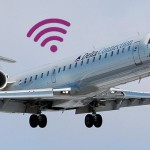 Delta Air Lines announced on July 27th, 2012 that Comair will cease operations on September 29, 2012 and the airline’s fleet of Canadair Regional Jets will be either retired or transferred to other airlines in the Delta Connection.
Delta Air Lines announced on July 27th, 2012 that Comair will cease operations on September 29, 2012 and the airline’s fleet of Canadair Regional Jets will be either retired or transferred to other airlines in the Delta Connection.
A memo was sent to all employees of Comair by Ryan Gumm, President of Comair, which stated the following:
Today, I am writing to let you know that Delta has made the difficult decision to cease Comair’s operations after September 29, 2012.
Delta recently announced its intent to reduce the overall number of 50-seat regional jets in its network from nearly 350 to 125 or fewer in light of the significant changes in the economic and competitive conditions in the airline industry. We believed this announcement would have a negative impact on Comair because we operate some of the oldest 50-seat aircraft in the Delta Connection fleet, which also have the highest unit cost per flight hour. And, in fact, Delta has decided to remove the remaining 16 Comair 50-seaters from the Delta network, leaving Comair with only 28 aircraft in scheduled service. This further reduction of Comair’s active fleet will only create higher unit costs, which equates to a business model that is no longer sustainable in this competitive regional environment.
I understand that today’s news is very difficult and raises many questions for you and your family. Human Resources is prepared to directly assist you during this time. They will post a memo and other documents on the Human Resources Epic page to keep you informed of the assistance available and to help answer many of your questions. We will also have staff available over the weekend to answer questions if needed. If after reviewing the information on Epic you have any additional questions or concerns, please do not hesitate to reach out to your departmental leadership as well.
The discontinuation of Comair’s operations is in no way a failure or a reflection of your work – it is an unfortunate necessity due to the economic limitations of our aging aircraft, cost structure, the long-term outlook for 50-seat aircraft, and our challenging industry and economy. The quality of our operations has continued to be outstanding during our lengthy restructuring efforts, and I am honored to have had the opportunity to lead such a committed team. I am asking that each of you recognize the importance of remaining focused on safety and the job at hand as we continue operations throughout the wind-down period. Your continued commitment and your dedication to a safe and reliable operation is a testament to the professional team we have built here at Comair.
Ryan Gumm, President of Comair
This decision was expected based on negotiations earlier this year with Delta’s feeder fleet pilot unions. Those negotiations revealed that Delta was planning to remove a significant number of fifty seat aircraft from the regional fleet. As Comair operated the highest percentage of these aircraft, draw downs were expected to hit the airline the hardest.
A memo from Don Bornhorst, Senior Vice President of Delta Connection, indicated that:
While regional flying has and will remain a key component of Delta’s network, customer expectations and the unit costs of regional flying have evolved. In response, Delta recently announced its plans to reduce the total number of regional jets in its network while adding more mainline flying. This includes reducing the number of 50-seat regional jets from nearly 350 aircraft to 125 or fewer in the upcoming years. As a result of this reduction and changes to its customer-focused business strategy, Delta has made the difficult decision to cease Comair’s operations.
Don Bornhorst, Senior Vice President of Delta Connection
Comair’s fleet represents approximately one percent of Delta’s network capacity. According to Delta, they expect the removal of Comair from Delta Connection operations will not cause any disruptions to customers and no significant adjustments to Delta’s flight schedule or locations served. Delta also added that it expected Cincinnati would continue to be an important market in Delta’s network and indicated that no reductions in the number of Delta flights are planned at Cincinnati as a result of this decision.
Comair has been in operation since April 1977, and currently employs about 2,000 people, half of them at Cincinnati-Northern Kentucky International Airport. The airline introduced the concept of regional jet commuter service with the introduction of the Canadair Regional Jet which the airline was one of the first operators of.
Comair has operated every major model of the Canadair Regional Jet save for the CRJ 1000 aircraft and at one time the airline operated the largest regional jet fleet in the world.
It is expected that since most of the CRJ100 and CRJ200 aircraft in Comair’s fleet are some of the highest time and oldest CRJs in operation, that the aircraft will be retired from service and parted out.
The airline also operates a small fleet of CRJ700 and CRJ900 aircraft which are expected to be transferred to either Skywest or Atlantic Southeast Airlines to supplement the fleets of those airlines.
The shutdown of Comair will mark the end of one of the pioneers of regional jet service in the world.


